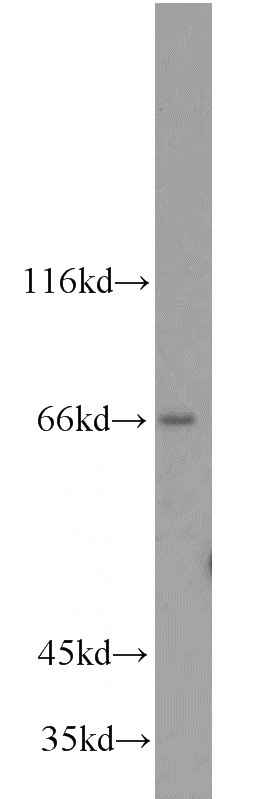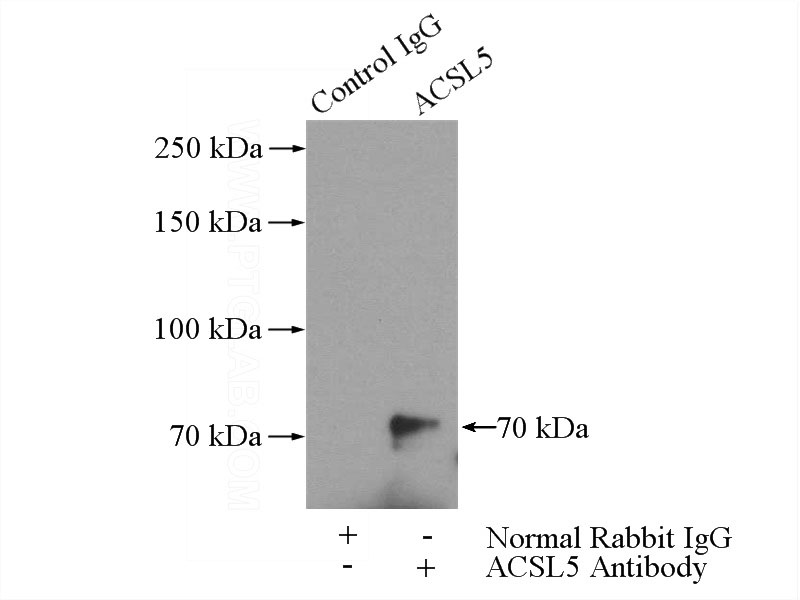-
Product Name
ACSL5 antibody
- Documents
-
Description
ACSL5 Rabbit Polyclonal antibody. Positive WB detected in mouse brain tissue, HeLa cells, mouse liver tissue. Positive IP detected in mouse brain tissue. Observed molecular weight by Western-blot: 66-70kd
-
Tested applications
ELISA, WB, IP
-
Species reactivity
Human,Mouse,Rat; other species not tested.
-
Alternative names
ACS2 antibody; ACS5 antibody; ACSL5 antibody; FACL5 antibody; LACS 5 antibody
-
Isotype
Rabbit IgG
-
Preparation
This antibody was obtained by immunization of ACSL5 recombinant protein (Accession Number: NM_016234). Purification method: Antigen affinity purified.
-
Clonality
Polyclonal
-
Formulation
PBS with 0.02% sodium azide and 50% glycerol pH 7.3.
-
Storage instructions
Store at -20℃. DO NOT ALIQUOT
-
Applications
Recommended Dilution:
WB: 1:500-1:5000
IP: 1:200-1:2000
-
Validations

mouse brain tissue were subjected to SDS PAGE followed by western blot with Catalog No:107698(ACSL5 antibody) at dilution of 1:1200

IP Result of anti-ACSL5 (IP:Catalog No:107698, 4ug; Detection:Catalog No:107698 1:600) with mouse brain tissue lysate 4000ug.
-
Background
Acyl-CoA synthetase 5, a member of the ACSL gene family that catalyzes the activation of long-chain fatty acids for lipid biosynthesis, is the only ACSL isoform that is both, located on mitochondria and functionally involved in enterocyte apoptosis.ACSL5 could play a role in promoting fatty acid-induced lipoapoptosis in hepatocytes as important mechanism in fatty liver-related disorders(PMID:20470896). ACSL5 is most abundant in liver, brown adipose tissue, and intestine and is located on both the mitochondrial membrane and endoplasmic reticulum(PMID:20798351). It has 3 isoforms produced by alternative splicing.
-
References
- Zhang S, Zheng L, Dong D. Effects of flavonoids from Rosa laevigata Michx fruit against high-fat diet-induced non-alcoholic fatty liver disease in rats. Food chemistry. 141(3):2108-16. 2013.
- Xu T, Zheng L, Xu L. Protective effects of dioscin against alcohol-induced liver injury. Archives of toxicology. 88(3):739-53. 2014.
- Fryer LG, Jones B, Duncan EJ. The endoplasmic reticulum coat protein II transport machinery coordinates cellular lipid secretion and cholesterol biosynthesis. The Journal of biological chemistry. 289(7):4244-61. 2014.
- Liu M, Xu L, Yin L. Potent effects of dioscin against obesity in mice. Scientific reports. 5:7973. 2015.
Related Products / Services
Please note: All products are "FOR RESEARCH USE ONLY AND ARE NOT INTENDED FOR DIAGNOSTIC OR THERAPEUTIC USE"
